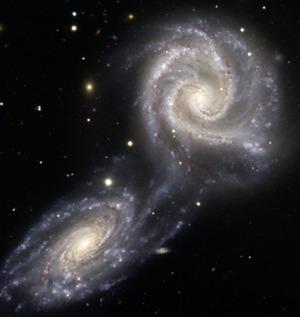Arp 271
Appearance
| Arp 271 | |
|---|---|
 Galaxies Drawn Together. Credit: ESO. | |
| Observation data (J2000 epoch) | |
| Right ascension | 14h 00m 48.3s[1] |
| Declination | −05° 47′ 25″[1] |
| Distance | 127 million light-years (39 Mpc) |
| Apparent magnitude (V) | 11.4[2] |
| Characteristics | |
| Apparent size (V) | 2.5[2] |
| Other designations | |
| NGC 5426 & NGC 5427, LEDA 50084, VV 21a, [VV2000c] J140325.9-060150, AGC 540006, 2MASX J14032604-0601509, VV 21, [VV2003c] J140325.9-060150, APG 271, MCG-01-36-003, [CHM2007] LDC 1026 J140326.04-0601509, [VV2006c] J140325.9-060150, 6dFGS gJ140326.1-060151, NVSS J140326-060149, [CHM2007] HDC 850 J140326.04-0601509, [VV98c] J140325.9-060150, IRAS 14008-0547, UGCA 381 [HB91] 1400-057. | |
Arp 271 is a pair of similarly sized interacting spiral galaxies, NGC 5426 and NGC 5427. It is not certain whether the galaxies are going to eventually collide or not. They will continue interacting for tens of millions of years, creating new stars as a result of the mutual gravitational attraction between the galaxies, a pull seen in the bridge of stars already connecting the two. Located 90 million light-years away, the Arp 271 pair is about 130,000 light-years across. It was originally discovered in 1785 by William Herschel. It is speculated,[3] [4] that the Milky Way will undergo a similar collision in about five billion years with the neighbouring Andromeda galaxy, which is currently located about 2.6 million light-years away.[5]
References
- ^ a b "SIMBAD Astronomical Database". Results for Arp 271. Retrieved 2010-09-22.
- ^ a b "The Interactive NGC Catalog Online". Results for NGC 5427. Retrieved 2010-09-22.
- ^ http://www.nasa.gov/mission_pages/hubble/science/milky-way-collide.html
- ^ http://www.nasa.gov/mp4/654254main_v1220j_H264l.mp4
- ^ [1]
External links
- Simbad: Arp 271
- Arp 271 — Galaxies Drawn Together, ESO picture of the week.
Wikimedia Commons has media related to Arp 271.
